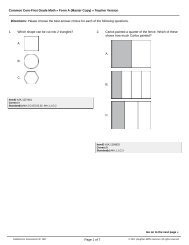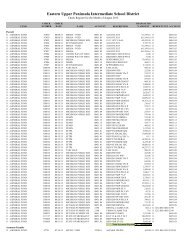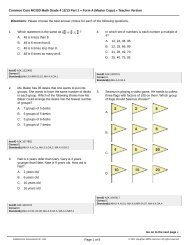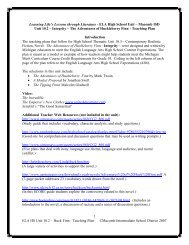Teaching Algebra with Manipulatives
Teaching Algebra with Manipulatives
Teaching Algebra with Manipulatives
You also want an ePaper? Increase the reach of your titles
YUMPU automatically turns print PDFs into web optimized ePapers that Google loves.
Chapter 5 <strong>Teaching</strong> Notes and Overview<br />
Answers<br />
1. 4, 2; 9, 3; 16, 4; 25, 5<br />
2. See students’ models.<br />
3. x 2, (x 2) 2 ,(x 2)(x 2);<br />
2x x, (2x x) 2 ,(2x x)(2x x);<br />
3xy xy, (3xy xy) 2 ,(3xy xy)(3xy xy);<br />
b 3, (b 3) 2 ,(b 3)(b 3)<br />
4. 10 5. 9<br />
3<br />
6. 0.2 7. <br />
1 1<br />
8. 2x 9. 2x 2 6<br />
10. 4x 2 y 2 14y 11. 27x 3 y 3 y<br />
<strong>Algebra</strong> Activity<br />
Recording Sheet<br />
Adding Radicals<br />
(p. 238 of this booklet)<br />
when graphing in the complex plane, ordered<br />
pairs are in the form (real, imaginary). As soon<br />
as students have completed Exercises 1–4,<br />
Exercises 5–7, and Exercise 8, you may want to<br />
stop and go over their answers and answer any<br />
questions they may have. Some students may<br />
be interested in investigating, solving, and<br />
graphing other similar equations. Encourage<br />
them to pursue these interests and to share<br />
their findings <strong>with</strong> the class.<br />
Answers<br />
1–3. See students’ work.<br />
4. square<br />
5–6. See students’ work.<br />
7. triangle<br />
8. See students’ work.<br />
9. regular hexagon<br />
<strong>Algebra</strong> 2—Chapter 5<br />
Use With the activity on page 252 in Lesson<br />
5-6 of the Student Edition.<br />
Objective Use dot paper to add radicals.<br />
Materials<br />
isometric dot paper<br />
Students will use the Pythagorean Theorem to<br />
construct a right triangle <strong>with</strong> hypotenuse of<br />
length 2 units on dot paper. They will extend<br />
the hypotenuse to twice its length and use the<br />
models to add the radicals. Students will also<br />
model other irrational numbers using the same<br />
method.<br />
Answers<br />
See Teacher Wraparound Edition p. 252.<br />
Mini-Project<br />
nth Roots of Negative Numbers<br />
(p. 239 of this booklet)<br />
Use With Lesson 5-9.<br />
Objective Find nth roots of negative numbers.<br />
Have students work in groups of two or three to<br />
complete the Exercises 1 through 9. Require<br />
students to do and show their work for<br />
Exercises 1, 5, and 8. Remind students that<br />
<strong>Algebra</strong> Activity<br />
Recording Sheet<br />
Adding Complex Numbers<br />
(p. 240 of this booklet)<br />
Use With the activity on page 272 in Lesson<br />
5-9 of the Student Edition.<br />
Objective Add complex numbers by modeling<br />
them on a coordinate plane.<br />
Materials<br />
grid paper<br />
straightedge<br />
Students will graph the first complex number<br />
from an addition equation on a coordinate grid.<br />
They will then move accordingly on the grid to<br />
add the next complex number. The new point<br />
represents the complex number that is the<br />
solution to the equation. Using the coordinate<br />
grid, students will also model the difference and<br />
absolute value of other complex numbers.<br />
Answers<br />
See Teacher Wraparound Edition p. 272.<br />
© Glencoe/McGraw-Hill 233 <strong>Teaching</strong> <strong>Algebra</strong> <strong>with</strong> <strong>Manipulatives</strong>







